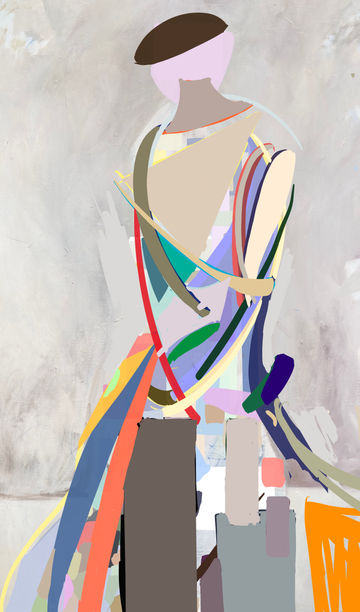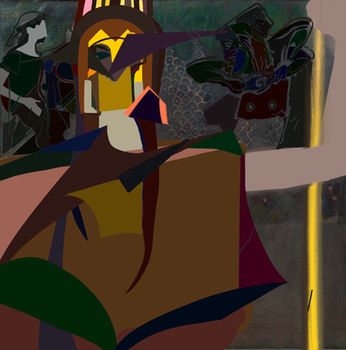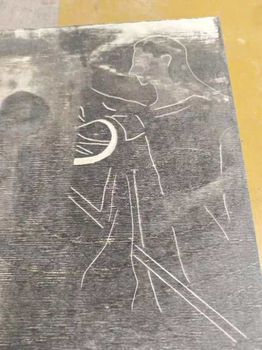Reflecting on the Process & Recording Ideas and Inspirations









Ringing 1:Origins and Reflections
In my Unit 3 Critical Reflection, I examined the portrayal of women by the Vienna Secession artists of the late 19th and early 20th centuries, critically considering how to reconstruct female narratives through a personal lens. Unlike my previous practice of appropriating canonical artworks, Ringing 1 emerges from an introspective exploration of personal experience, seeking to depict the complexities of modern womanhood as negotiated between societal expectations and self-perception.
The initial stages of this work focused on my identity as a woman and the tensions arising from societal pressures. I reflected on how these influences shaped my relationship with my sister and our shared psychological and familial dynamics. The work uses bodily forms and gestures to symbolize the mental entanglements and emotional contradictions experienced by sisters navigating the gendered roles and cultural expectations of a Southern Chinese family. As Werner Haftmann aptly observes, "The movement and form of lines reveal the artist’s psychological state." Inspired by this idea, I incorporated irregular, variably paced lines and curves into the composition, symbolizing the internal and external struggles of women—oscillating between softness and resilience, calm and intensity.
The background of Ringing 1 is constructed from multicolored triangular blocks, symbolizing the multiplicity of female identities and emotions. These are layered with varying opacities of white acrylic, creating a "veil-like" effect that metaphorically represents the phenomenon of women concealing their emotional depths in contemporary society. This repetitive layering process held a meditative quality for me, functioning not only to build visual depth but also as a method of self-healing and achieving inner equilibrium amidst external pressures.
At the center of the composition, I depicted an abstracted embrace between my sister and me. Through processes of deconstruction, reassembly, and integration, I merged our forms into a unified abstract entity, intertwining color blocks and dynamic lines to evoke motion and entanglement. The absence of defined facial features and contours conveys the ambiguity of modern women’s roles and identities. Overlapping and interweaving shapes and colors suggest the interplay of self-recognition and societal expectations, illustrating the conflicts and synergies inherent in these negotiations.
The creation of Ringing 1 was characterized by deliberate pauses and reflections, marking a departure from the habitual impulses that often drive my work. Instead, I embraced a conscious process of constructing symbolic meaning within the composition. This approach transformed the act of painting into a form of self-analysis, using visual elements to articulate emotional fluctuations and probe the intersections between self-awareness and the subconscious. Through this process, Ringing 1 became a pivotal work in my artistic practice, representing a critical engagement with both emotional expression and conceptual exploration.
Ringing1 ,150✖100cm,oil on canvas, 2024
Ringing2 : A Reconstruction and Critique from Classic to Contemporary
In Ringing2, I chose to reinterpret Gustav Klimt's early work, Portrait of Sonja Knips. Klimt’s use of soft tones, the graceful posture of the subject, and the blurred interplay between figure and background imbue the painting with an idealized representation of femininity, emphasizing the purity and spiritual independence of the protagonist. However, this portrayal remains bound by the romanticized and fixed notions of women prevalent during Klimt's time.
Inspired by Picasso's approach to transformation, I employed abstraction in this piece to reinterpret Klimt’s figurative representation through geometric shapes and lines, translating it into a contemporary visual language. This transformation extends beyond formal innovation, serving as an exploration of the fluidity of female identity and the layered complexity of women’s emotional and social states. Drawing on Judith Butler’s theory of ”gender performativity“, which posits that gender and identity are socially constructed rather than inherent, I retained Klimt's soft tonal palette and simple background to accentuate the reconstructed subject, directing the viewer’s focus toward the composition of shapes and colors.
Using abstract painting techniques, I fragmented and reassembled the traditional contours and physical features of the figure through geometric forms and linear elements. This deliberate blurring of specific identity challenges the rigidity of gender roles imposed by traditional societal values, underscoring the dynamic and evolving nature of female identity. In the work, gender and physical traits are intentionally obscured, symbolizing a rejection of static definitions and affirming the continuous process of reorganization, reconstruction, and redefinition of identity.
Through this creation, I aim to provoke reflection on modern female identity while critiquing the stereotypical depictions of gender and roles in traditional art. Ringing2 is not merely a visual reconstruction of Klimt’s classic work but also a challenge to and dialogue with societal norms and the conventions of gender representation.

Serena Pulitzer Lederer,190✖85cm,oil on canvas, 1899
Ringing2 ,150✖100cm,oil on canvas, 2024
Please click the (right arrow) below to explore the process and steps.
Gustav Klimt's Pallas Athene and the Reconstruction and Critique in My Work Armor
Klimt's Pallas Athene (1898) portrays the Greek goddess of wisdom and war, symbolizing reason, strength, and protection. In the late 19th-century Viennese context, this figure carried profound symbolic significance as a challenge to traditional systems. Serving as the poster for the second Vienna Secession exhibition, Athena embodied the Secessionists' ideals of artistic independence, the power of knowledge, and female autonomy.
In the painting, Klimt employs gold extensively in Athena's armor and the ornamental background details. The composition is centralized and symmetrical, lending the figure a sense of stability and authority. Athena’s stern expression, the shimmering golden scales of her armor, and her spear contrast starkly with the darker tones of the background, emphasizing her majesty and divinity. The inclusion of a playful, mocking mask on her armor introduces an element of irony, complicating the otherwise solemn tone of the piece and imbuing it with a surreal quality.
Armor: Abstraction and Modern Reconstruction
Drawing on Pallas Athene , I created Armour to reinterpret the classical figure through abstraction, exploring themes of female multiplicity and strength. Inspired by Picasso's Las Meninas series, which deconstructs Velázquez's iconic painting, I employed flat color planes and layered geometric shapes to construct depth and complexity, diverging from traditional chiaroscuro techniques. Each fragmented shape represents a distinct perspective, reflecting the multifaceted nature of female identity and its fluidity.
Klimt’s decorative elements were reimagined in my work. The intricate scales and golden embellishments were replaced with large, flat color fields and gradient lines produced through woodcut printing techniques. This reductionist approach transforms the figurative goddess into an interplay of geometric shapes and abstract color blocks, introducing a contemporary aesthetic while breaking away from conventional representational modes.
Redefining Female Identity
Through Armor, I aim to retain Klimt's representation of feminine authority and sanctity while reframing it within a modern context to emphasize themes of self-protection and internal strength. The "armor" becomes a metaphorical device, symbolizing a psychological shield against societal pressures. By abstracting the traditional figure, I challenge the rigid gender constructs perpetuated in classical art, advocating instead for an evolving, multifaceted understanding of female identity. This work bridges past and present, critiquing historical conventions while offering a contemporary narrative of resilience and redefinition.
Other works

Pallas Athene,Gustav Klimt, 50✖50cm,oil on canvas, 1898
Armor,50✖50cm,oil on canvas, 2024
Please click the (right arrow) below to explore the process and steps.

SILENT,150✖100cm,oil and acrylic on canvas, 2024
Away from the close,158✖178cm,oil,spray,acrylic,oil pastel on canvas, 2024
Please click the (right arrow) below to explore the process and steps.





























